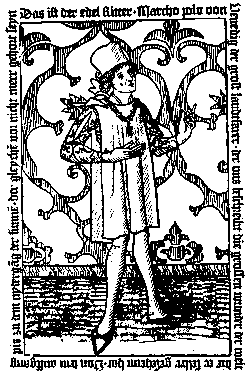
European merchant and traveller, b. c. 1254 (Venice or Curzola), d. 8 January 1324 (Venice).
Marco Polo belonged to a merchant family of Venice who had gained wealth through trade with the Middle and Far East. His grandfather and father had already travelled widely in pursuit of their business, and Marco Polo was already 15 when his father returned from Mongolia in 1269 and met his son for the first time.
The Mongol emperor Kublai Khan had given Marco's father letters for the pope, in which he asked for one hundred men "acquainted with the Seven Arts" to augment the cultural standing of his court. In 1271 his father left to return to Mongolia, and Marco accompanied him.
At the Strait of Hormuz the Polos decided against a risky sea voyage and began their long journey over land. In 1274 or 1275 they arrived in the emperor's summer capital Shang-tu, followed him to his winter capital Ta-tu (today's Beijing) and lived in China in the emperor's service for 16 or 17 years.
In 1290 or 1292 the Polos accompanied a Mongol princess, a future consort for the Persian emperor Arghun Khan, on her voyage to Persia. A fleet of 14 ships with 600 passengers and sailors on board departed from Ch'uan-Chou on Taiwan Strait and sailed through Macassar Strait (between today's Malaysia and Indonesia) along the Indian coast to Hormuz. When the party arrived in Khorasan (in today's Iran) Arghun Khan had died, so the princess was handed over to his son.
In 1295 the Polos returned home to Venice, where the arrival of faces long believed dead caused great surprise and celebration. Not long after, however, Marco Polo was taken prisoner in a skirmish with the rival city of Genoa and imprisoned. He used the time to dictate his recollections of the countries he had seen to a fellow prisoner, a well-known writer of romances.
The resulting book, originally called Divisament dou Monde ("Description of the World") but soon known as Il milione or "The Travels of Marco Polo," was an instant success. Hundreds of copies were produced and spread throughout Italy; translations into Latin and a dozen other languages appeared within years. More than 140 different versions of the original text were produced in the process, since every editor took liberty to add or correct what appeared unbelievable or eliminate what could cause affront. (The idea that people live at the equator was considered particularly heretic.)
For many years Il milione was read more as a fantastic romance of a Mongol khan. But Polo's detailed localization of regions where valuable spices can be found was taken seriously by later explorers, and during the period of European exploration his book was read as a travel report and had a great influence on the view of the world.

Title page of the first printed edition of
The Travels of Marco Polo
(1477)
The text around the frame says in translation: "This is the noble knight Marco Polo the great traveller who describes for us the great wonders of the world, which he himself saw from sunrise to sunset, such as have never been heard of before."